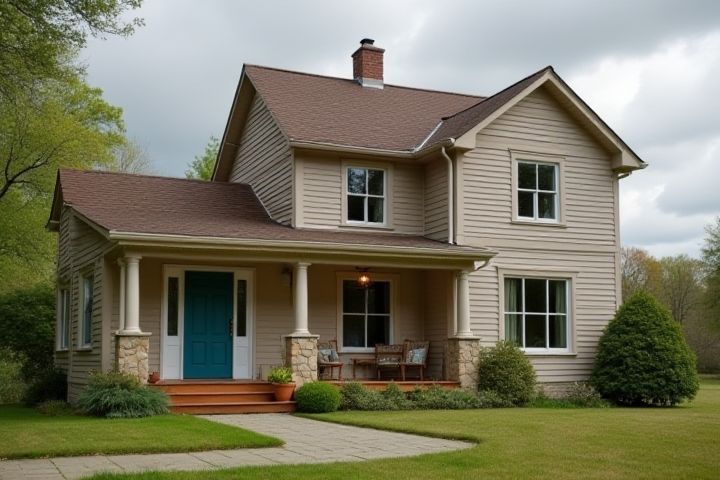
A house settles primarily due to the natural compression of the soil beneath its foundation over time. When constructed, the weight of the house exerts pressure on the ground, causing the soil particles to compact, which can lead to minor shifts in the foundation. Variations in moisture levels, such as droughts or heavy rainfall, can also affect the soil's stability, causing it to expand or contract. As temperature changes occur, materials like wood and concrete can expand or shrink, contributing to settling. Understanding these factors can help you recognize signs of settling and determine if further foundation work is necessary.
Why Does A House Settle
Soil composition
Soil composition plays a vital role in the settling of a house, as it affects the stability and load-bearing capacity of the foundation. The presence of clay, sand, silt, and organic material can lead to differential settlement, with clay-rich soils exhibiting significant swelling and shrinkage based on moisture levels. Properties such as soil density and moisture content can cause movement in the foundation, especially if the soil is poorly compacted or contains high levels of water. Understanding the specific soil composition before construction can help you mitigate potential settling issues, ensuring a durable and stable home.
Moisture variation
Moisture variation is a critical factor in house settling, as changes in soil moisture content can lead to expansion or contraction of the earth beneath a structure. When soil absorbs water, it expands, while dry conditions cause it to shrink, potentially leading to uneven settling and foundation issues. According to experts, fluctuations in moisture levels can cause up to 50% of foundation movement in residential properties. Maintaining consistent moisture levels through proper drainage and landscaping practices can significantly reduce the risk of these settlement problems.
Temperature changes
Temperature changes cause materials in a house, such as wood and concrete, to expand and contract. This natural movement can lead to stress on joints and connections, resulting in structural settling over time. In regions with significant temperature fluctuations, properties may experience shifts of up to 1 inch per year due to these environmental effects. Understanding the impact of temperature on your home's foundation can help you identify potential issues before they become serious problems.
Tree root growth
House settling can be significantly influenced by tree root growth, as roots extend and search for water and nutrients in the soil. The expansion and contraction of these roots can create shifts in the ground's stability, leading to uneven settling of the foundation. In particular, large trees with extensive root systems may draw moisture from the surrounding soil, causing it to shrink and subsequently leading to subsidence. It's crucial for homeowners to monitor tree placement and root activity, as addressing these factors can help mitigate potential foundation issues in your property.
Construction materials
House settlement often occurs due to the compressibility of construction materials and the underlying soil. Natural materials like wood, concrete, and masonry exhibit different rates of expansion and contraction based on moisture and temperature changes, which can lead to structural shifts. Poorly compacted soil or weak foundation materials can exacerbate settlement issues, compromising your home's stability. Understanding the properties of materials used in construction allows for better planning and preventative measures to ensure long-lasting integrity of your building.
Building age
The age of a building significantly influences its settling process, primarily due to natural material shift and decay over time. In structures aged 10 years or more, wooden elements may warp or shrink, while concrete and masonry can experience slight compressive settling. Typically, buildings that are 50 years or older exhibit more pronounced settling issues, often necessitating structural assessments. Understanding the age-related factors helps homeowners anticipate maintenance needs and ensures that potential settlement complications are addressed early.
Foundation type
The type of foundation plays a crucial role in how a house settles, as different materials and construction methods respond differently to soil conditions. For instance, concrete slab foundations, which are common in warmer climates, may experience less movement due to less soil exposure, yet can still crack as the ground shifts. In contrast, pier and beam foundations provide better ventilation and can adapt to slight soil movements, but may also lead to uneven settling if not properly installed. Understanding the relationship between foundation type and soil behavior can help you address potential settlement issues proactively, preserving your home's structural integrity.
Nearby excavation
A house settles primarily due to nearby excavation activities that disturb the soil layers beneath the foundation. When soil is excavated, it can lead to soil compaction or remove support, shifting the structure's load. This displacement can result in uneven settling, causing cracks in walls and foundations. It's crucial to monitor excavation projects in your vicinity to understand potential impacts on your home's stability.
Seismic activity
A house settles due to various factors, one of which is seismic activity, which can induce ground shaking and soil displacement. In areas prone to earthquakes, seismic waves can compress or loosen the soil beneath a foundation, leading to uneven settlement. This can cause structural issues, such as cracks in walls or foundations, affecting up to 30% of homes in seismic zones. You can mitigate these risks through proper engineering and foundation design, ensuring your home remains stable during seismic events.
Drainage system
A house can settle due to various factors, with an improper drainage system being a primary contributor. Poor drainage can lead to water pooling around the foundation, causing soil erosion and shifts that result in settling. Inadequate drainage systems may also introduce excess moisture, leading to soil expansion or contraction, which further destabilizes the foundation. Maintaining a functional drainage system is crucial, as nearly 70% of foundation issues can be traced back to water management failures.
